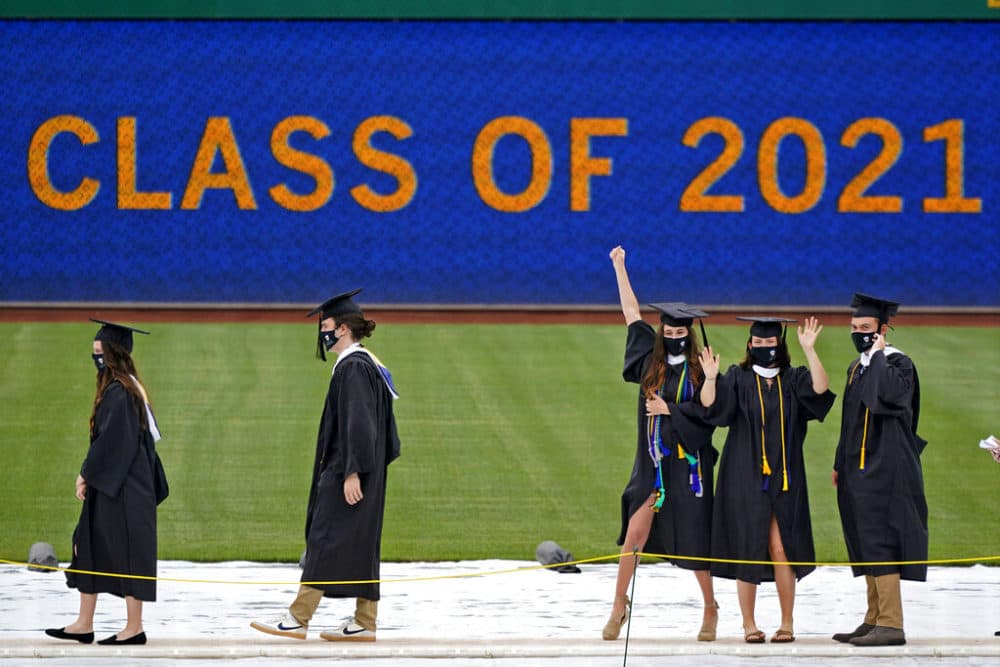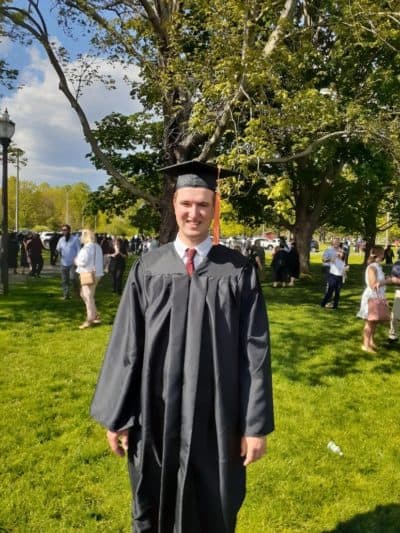Advertisement
Commentary
Public College Is Expensive, Too. My Son Has $27K In Debt — From UMass

The envelopes started arriving in the spring of my son’s first year in college: Citizens Bank, Wells Fargo, Sallie Mae.
“Find Your Perfect Student Loan!” proclaims one — as if there is such a thing — or “Know They’re Covered from Orientation Until Graduation ... ” They do not mention what happens after graduation. I hid them from my child, who graduated from UMass Amherst this month with $27,000 in federal student loans. He has enough debt already.
In the U.S., 45 million borrowers now hold more than $1.7 trillion in student debt, second in total consumer debt only to mortgage borrowing. Almost two decades ago, Massachusetts’ public university graduates had the 49th lowest student debt in the nation, but by 2016, debt levels had climbed to 10th highest, an average of $30,248 per borrower.

And no wonder. The commonwealth has cut funding for higher education 30% per student, in inflation-adjusted dollars, between 2001 and 2019, due in large part to tax cuts that have cost the state over $4 billion annually and overwhelmingly favor the state’s wealthiest. In 2001, Massachusetts families shouldered about 32% of the costs of a public university education; in 2018, that figure had almost doubled, to 62%, as our public colleges and universities saw some of the sharpest tuition-fee increases in the nation.
Without financial aid of some sort, my child and many more across the state would simply not be attending college. Tuition and fees for in-state students at UMass’s flagship Amherst campus this year clock in at $16,439, not including books or other necessities — out-of-reach for many families. And the full live-in sticker price? About $31,000 per year. When grants, wages and scholarships fall short, as they almost always do, students turn to loans, which can have long-lasting, negative effects. Student debt is associated with worse physical and mental health outcomes and delayed adult lifestyle choices such as marriage, childrearing and homeownership.
“I will not be taking out a second mortgage to put you through college,” I told my son his senior year in high school, after college acceptance and financial aid packets arrived. The private colleges to which he had been accepted were immediately off the table; even the one that claimed they “met full need” cost $25,000 more annually, after financial aid, than UMass. Our public college system was clearly the best option.
Advertisement
I have tiptoed my way through my son’s college years, fingers crossed. In the precarious single-parent calculations that I am always running, we have managed to meet financial obligations with the help of a dizzying array of grants, federal student loans, work-study and off-campus jobs — up to three at a time for my child — and the scholarships my son laboriously applied to over many long winter nights. I have not needed to find a third job in addition to the two I already have. My son has not been food- or housing-insecure, like an extraordinary 56% of Massachusetts public college students.
I have tiptoed my way through my son’s college years, fingers crossed.
In many ways, we have been lucky, but still, I have held my breath every July, waiting to see the coming year’s tuition/aid package, and thus, final out-of-pocket tally. For sophomore year, tuition bills contained an $844 increase, one described at the time — by men who have likely always had lucrative jobs — as “moderate” (UMass Board of Trustees Chair Rob Manning) and as one that “minimizes the ... impact on students and families” (UMass President Martin Meehan). The following year saw another $877 rise. It took a pandemic to put a hold on cost increases for my son’s senior year.
In a state renowned for education, it is time to reinvest in our students. Senate Bill 824, known as the CHERISH Act, would return funding for public higher education in Massachusetts to 2001 levels, while freezing tuition and fees for five years. Massachusetts’ Fair Share Amendment, the so-called millionaire’s tax, is a proposed constitutional amendment that will tax incomes above $1 million by 4%, bringing in an expected $2 billion in annual revenue that will be earmarked for education, infrastructure and transportation needs in the commonwealth.
But investing more public dollars in higher education is not just good for hungry, cash-strapped college students; it is good for the state. Research shows that college graduates are both significantly healthier and much less likely to need public assistance over the course of their lifetimes. Compared to high school graduates, those with a college degree return more than 2 1/2 times as much in tax revenue to state and local governments, an average of $137,000 per person.
Such an investment has win-win written all over it. It is past time to make access to affordable higher education a right, not a privilege.
